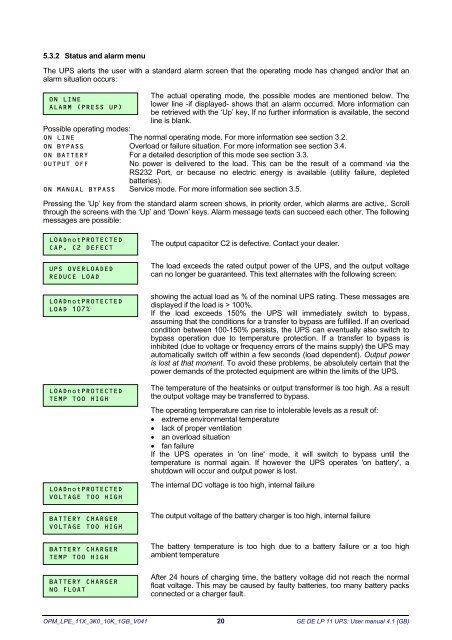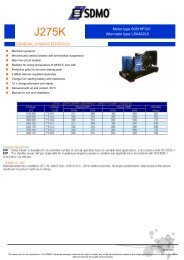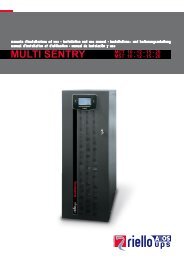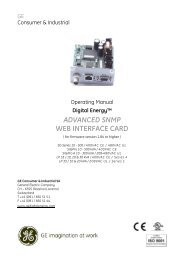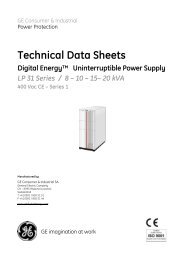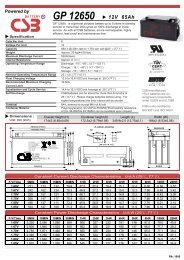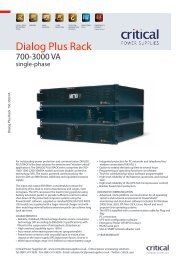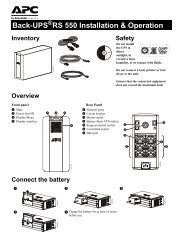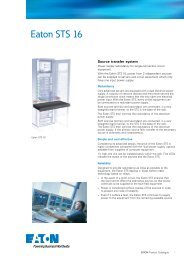Operation Manual - ASSMANN IT-Solutions AG
Operation Manual - ASSMANN IT-Solutions AG
Operation Manual - ASSMANN IT-Solutions AG
- No tags were found...
Create successful ePaper yourself
Turn your PDF publications into a flip-book with our unique Google optimized e-Paper software.
5.3.2 Status and alarm menuThe UPS alerts the user with a standard alarm screen that the operating mode has changed and/or that analarm situation occurs:ON LINEALARM (PRESS UP)The actual operating mode, the possible modes are mentioned below. Thelower line -if displayed- shows that an alarm occurred. More information canbe retrieved with the ‘Up’ key. If no further information is available, the secondline is blank.Possible operating modes:ON LINE The normal operating mode. For more information see section 3.2.ON BYPASS Overload or failure situation. For more information see section 3.4.ON BATTERY For a detailed description of this mode see section 3.3.OUTPUT OFFNo power is delivered to the load. This can be the result of a command via theRS232 Port, or because no electric energy is available (utility failure, depletedbatteries).ON MANUAL BYPASS Service mode. For more information see section 3.5.Pressing the ‘Up’ key from the standard alarm screen shows, in priority order, which alarms are active,. Scrollthrough the screens with the ‘Up’ and ‘Down’ keys. Alarm message texts can succeed each other. The followingmessages are possible:LOADnotPROTECTEDCAP. C2 DEFECTUPS OVERLOADEDREDUCE LOADLOADnotPROTECTEDLOAD 107%LOADnotPROTECTEDTEMP TOO HIGHLOADnotPROTECTEDVOLT<strong>AG</strong>E TOO HIGHBATTERY CHARGERVOLT<strong>AG</strong>E TOO HIGHBATTERY CHARGERTEMP TOO HIGHBATTERY CHARGERNO FLOATThe output capacitor C2 is defective. Contact your dealer.The load exceeds the rated output power of the UPS, and the output voltagecan no longer be guaranteed. This text alternates with the following screen:showing the actual load as % of the nominal UPS rating. These messages aredisplayed if the load is > 100%.If the load exceeds 150% the UPS will immediately switch to bypass,assuming that the conditions for a transfer to bypass are fulfilled. If an overloadcondition between 100-150% persists, the UPS can eventually also switch tobypass operation due to temperature protection. If a transfer to bypass isinhibited (due to voltage or frequency errors of the mains supply) the UPS mayautomatically switch off within a few seconds (load dependent). Output poweris lost at that moment. To avoid these problems, be absolutely certain that thepower demands of the protected equipment are within the limits of the UPS.The temperature of the heatsinks or output transformer is too high. As a resultthe output voltage may be transferred to bypass.The operating temperature can rise to intolerable levels as a result of:• extreme environmental temperature• lack of proper ventilation• an overload situation• fan failureIf the UPS operates in 'on line' mode, it will switch to bypass until thetemperature is normal again. If however the UPS operates 'on battery', ashutdown will occur and output power is lost.The internal DC voltage is too high, internal failureThe output voltage of the battery charger is too high, internal failureThe battery temperature is too high due to a battery failure or a too highambient temperatureAfter 24 hours of charging time, the battery voltage did not reach the normalfloat voltage. This may be caused by faulty batteries, too many battery packsconnected or a charger fault.OPM_LPE_11X_3K0_10K_1GB_V041 20 GE DE LP 11 UPS: User manual 4.1 (GB)


